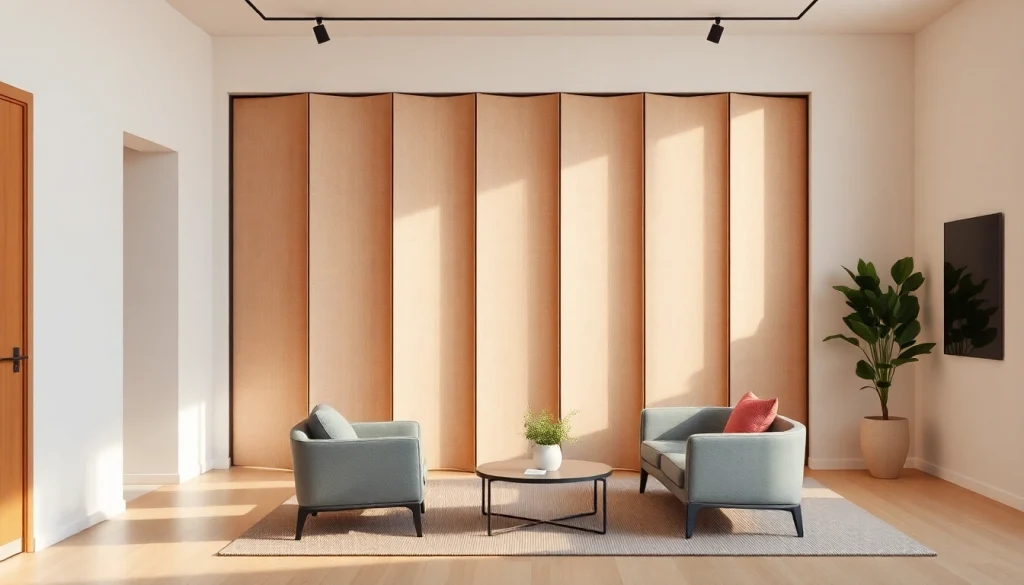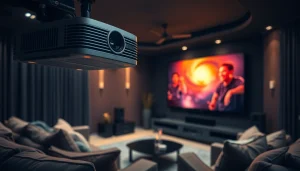
Understanding Folding Partition Walls
Definition and Purpose of Folding Partition Walls
A Folding Partition Wall is a flexible wall system designed to create versatile spaces by dividing large areas into smaller, usable segments. These partitions are typically constructed of lightweight materials that can be easily manipulated to open or close off spaces as required. The primary purpose of these walls is to enhance spatial efficiency by allowing rooms to be reconfigured quickly and easily, making them ideal for both residential and commercial settings.
Benefits of Using Folding Partition Walls in Your Space
The benefits of implementing folding partition walls in your environment are numerous and can significantly impact functionality, aesthetics, and cost-efficiency. Here are some key advantages:
- Flexibility: Folding partition walls provide unmatched adaptability, transforming large areas into multi-functional spaces that can accommodate varied activities.
- Space Optimization: By dividing rooms, you can maximize the utility of available square footage, allowing for different purposes within the same space.
- Cost-Effective: Installing folding partitions can be more economical compared to constructing permanent walls, making it a viable option for budget-conscious renovations or upgrades.
- Acoustic Control: Many folding partitions are designed with soundproofing capabilities, enhancing privacy and reducing noise pollution between spaces.
- Easy Installation and Maintenance: Compared to traditional walls, folding partitions are easier to install and maintain, requiring less time and labor during setup.
Common Applications and Use Cases
Folding partition walls have a broad spectrum of applications across various domains. Here are some common use cases:
- Office Spaces: In modern workplaces, folding partitions are frequently used to create collaborative zones, meeting rooms, or private offices that can be adjusted according to workforce needs.
- Educational Institutions: Schools and universities benefit from folding partitions to create temporary classrooms or multi-purpose halls that can adapt to different events like lectures, exhibitions, or performances.
- Hospitality: Hotels often deploy folding walls in banquet halls or conference rooms to create varying sizes of event spaces based on attendance, ensuring optimal accommodation.
- Residential: Homeowners use folding partitions to redefine living spaces, providing a dynamic solution for studios, lofts, or family rooms where flexibility is desired.
Types of Folding Partition Walls
Differences Between Accordion and Bi-Folding Systems
Folding partition walls come in various designs, each suited for specific needs. The two most popular types are accordion and bi-folding systems. Understanding their differences is crucial for selecting the right partition for your space.
Accordion Systems
Accordion folding partitions consist of multiple panels that fold back against each other when opened. They are ideal for creating wide openings, enabling seamless transitions between spaces. Accordion systems are often used in large areas, such as conference rooms or gymnasiums, where full clearance is needed.
Bi-Folding Systems
Bi-folding partitions feature panels that fold in pairs around a central hinge. This design typically provides a more elegant look and suits spaces requiring frequent adjustments but does not necessitate complete opening. They work well in residential settings, such as separating sections of open-plan homes.
Material Options for Folding Partition Walls
Choosing the right material for your folding partition wall is vital as it influences durability, sound control, aesthetics, and cost. Here are some common materials:
- Wood: Often used for its aesthetic appeal, especially in residential settings, wood partitions can provide warmth and character. However, they may lack some sound insulation compared to other materials.
- Vinyl: Vinyl-coated partitions are popular for their affordability, variety of designs, and ease of maintenance. They are often used in commercial spaces due to their practical qualities.
- Glass: Glass folding partitions are increasingly favored for their modern look and ability to maintain natural light within spaces. They can also come with soundproofing features, making them versatile for both aesthetic and functional applications.
- Fabric: These flexible partitions can add color and texture to a room while often being sound-absorbent. Fabric options also allow for easy customizations, catering to specific design themes.
Comparative Overview: Acoustic vs. Non-Acoustic Partitions
When selecting a folding partition wall, one crucial consideration is whether to opt for acoustic or non-acoustic options. This decision greatly influences the intended functionality of the space.
Acoustic Partitions
Acoustic folding walls are specifically designed to absorb sounds, making them ideal for environments where privacy and noise control are paramount. High-density materials and unique construction techniques help to minimize sound transmission, ensuring that adjacent spaces remain undisturbed. Common applications include:
- Conference rooms
- Studios
- Multi-purpose event centers
Non-Acoustic Partitions
Non-acoustic walls focus on providing a flexible and functional division of spaces without specialized soundproofing features. These structures are often more lightweight and economical, making them a practical choice for environments where noise control is not a major concern. Popular uses include:
- Classrooms
- Exhibition areas
- Restaurants
Installation Process for Folding Partition Walls
Pre-Installation Considerations and Site Assessment
Before installing a folding partition wall, thorough planning and assessment of the site are essential. Here are key pre-installation considerations:
- Space Measurement: Assess the dimensions of the area where the partition will be installed, considering ceiling height and floor space. Accurate measurements ensure a proper fit and functionality.
- Purpose Clarification: Define how the space will be used after installation. Understanding specific usage requirements will help in selecting the right type and configuration of folding partition.
- Design Integration: Consider the overall aesthetic of the space and how the partition will complement or enhance the existing decor. Material, color, and style choices should align with the overall design vision.
- Accessibility and User Needs: Evaluate who will use the partitions most frequently. Ensure that the design accommodates accessibility requirements or any specific needs of potential users.
Step-by-Step Guide to Installing Folding Partition Walls
The installation of folding partition walls can typically follow these steps:
- Gather Materials: Ensure that all necessary tools, materials, and hardware are available before starting. This includes panels, tracks, and any specialized installation equipment.
- Prep the Area: Clear the installation site, ensuring that the floor and ceiling are clean and free from obstructions. Check for level surfaces, as uneven floors can impact the installation’s success.
- Install Tracks: Attach the overhead track to the ceiling. It must be securely fastened to endure the weight and movement of the panels. Use a level to ensure proper alignment.
- Hang Panels: Begin mounting the panels onto the track. Starting from one end, raise each panel and lock them into place as specified by the manufacturer’s instructions.
- Adjust and Test: Once all panels are hung, test the folding mechanism to ensure smooth operation and make necessary adjustments for alignment and functionality.
- Secure and Finish: After confirming that the installation is successful, complete any final touches, such as adding seals or trim pieces to complete the look.
Common Challenges and Troubleshooting Tips
While installing folding partition walls can often be straightforward, various challenges may arise. Here are common problems and suggested troubleshooting methods:
- Poor Alignment: If the panels do not align correctly, double-check the installation of the overhead track. Adjust it as necessary, ensuring it is straight and level.
- Difficulty in Opening/Closing: If panels become stuck, inspect the track for debris or obstructions. Lubricating the track may also help the panels operate smoothly.
- Sound Leakage: For acoustic partitions, if soundproofing is inadequate, review the seals and inspect for gaps. Depending on the model, consider adding additional sound-absorbing materials.
Maintaining Folding Partition Walls
Routine Maintenance Practices for Longevity
To ensure that folding partition walls function optimally over time, regular maintenance is vital. Here are some practices to incorporate:
- Regular Cleaning: Wipe down panels and tracks to remove dust and debris. Use appropriate cleaning solutions that do not harm the materials.
- Lubrication: Periodically lubricate moving parts, specifically the tracks and hinges, to prevent rust and ensure ease of operation.
- Inspection: Routinely check for signs of wear, such as loose panels or misalignment, and address issues promptly to avoid escalation.
Repairing Common Issues with Folding Partition Walls
Even with the best maintenance practices, unforeseen issues may occur. Here are common problems and their solutions:
- Panel Damage: For physical damage to panels, assess whether a repair or a full replacement is necessary. Minor dents may be fixable with fillers, while more significant issues may require replacing the panel.
- Track Wear: If the track becomes worn or damaged, it may need realignment or replacement. Never attempt to operate panels on a compromised track, as this could lead to further damage.
When to Seek Professional Assistance
Though many maintenance tasks can be performed independently, certain situations require professional expertise. Consider seeking professional help in the following cases:
- Complex Repairs: For complicated issues beyond basic maintenance, hiring a specialist is advisable to ensure proper repair work.
- Initial Installation: If you’re unfamiliar with installation techniques or if the project is large-scale, hiring a professional can ensure the job is done safely and correctly.
- Acoustic Performance Issues: For concerns regarding sound balance or control that persist despite proper maintenance and installation practices, consultation with an acoustics expert may be beneficial.
Designing with Folding Partition Walls
Creative Layouts Using Folding Partition Walls
Folding partitions offer unrivaled design flexibility, allowing for creative layouts in various settings. Here are some innovative ideas:
- Zoned Areas: Use folding partitions to create distinct zones within open spaces, such as a work area separated from a lounge area in an office.
- Dynamic Event Spaces: In settings like banquet halls, adjust partitions to configure the space based on the event type, accommodating various setups and capacities.
- Temporary Rooms: In transitional spaces like community centers, implement folding walls to create temporary classrooms, meeting spaces, or even storage areas.
Incorporating Aesthetics: Colors and Styles
The design of folding partition walls goes beyond functionality. Choosing the right colors and styles can enhance the overall aesthetics of a space. Consider the following:
- Color Coordination: Align the color of the partitions with the surrounding décor. Neutral tones may work well for professional settings, while vibrant colors can energize creative environments.
- Material Selection: The choice of materials can affect the visual appeal significantly. Opt for transparent glass to create an airy feel or textured surfaces for added warmth.
- Custom Designs: Custom fabrics or prints on partitions can inject personality into spaces while fulfilling design requirements, making them a focal point or a subtle addition depending on the vision.
Case Studies: Successful Projects Featuring Folding Partitions
Understanding how folding partition walls have been successfully implemented can provide valuable insights. Here are two noteworthy case studies:
1. Corporate Office Redesign
A tech company wanted to maximize efficiency in their new office layout. By installing acoustic folding partitions, the company created separate project rooms that could be expanded or contracted based on project needs. Feedback indicated a significant increase in team productivity and collaboration, thanks to the optimal use of space.
2. Educational Campus Revamp
A university aimed to enhance its event hosting capabilities. By integrating glass folding walls into their main auditorium, the institution successfully transformed the space from a single large lecture hall into multiple smaller seminar rooms. This adjustment allowed for diverse events, ranging from conferences to student orientations, catering to different audience sizes effectively.






